Texas Rig 101 (Setup and Fishing Guide with Pictures)
PUBLISHED 16 AUGUST 2023
by Robert Ceran
Are you planning to throw a Texas rig for bass, but aren’t sure how to set it up, or how to fish it for optimal results?
While the Texas rig is without a doubt one of the best bottom fishing setups for bass, it can be tricky to set up and to fish for the best results.
In this article I’ll show you how to set up the Texas rig, and will aso cover what baits to use with it, and how to use it to put more fish in your boat. 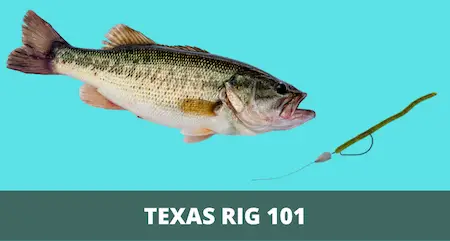
What is a Texas rig (and what is it good for)?
A Texas rig is a weedless bottom fishing rig used for bass fishing, and consists of a bullet weight threaded onto the line in front of an offset worm hook, and baited with a soft plastic bait.
Due its heavy bullet sinker and weedless rigging, the Texas rig can easily penetrate dense vegetation, and is therefore ideal for targeting bass in heavy cover without getting snagged (a quality that it shares with the Carolina rig for bass).
This setup is great for catching bass in shallow water around grass beds, laydowns, brush piles and other cover. And since it sinks fast in the water column, it also performs well for targeting bass in deep water. 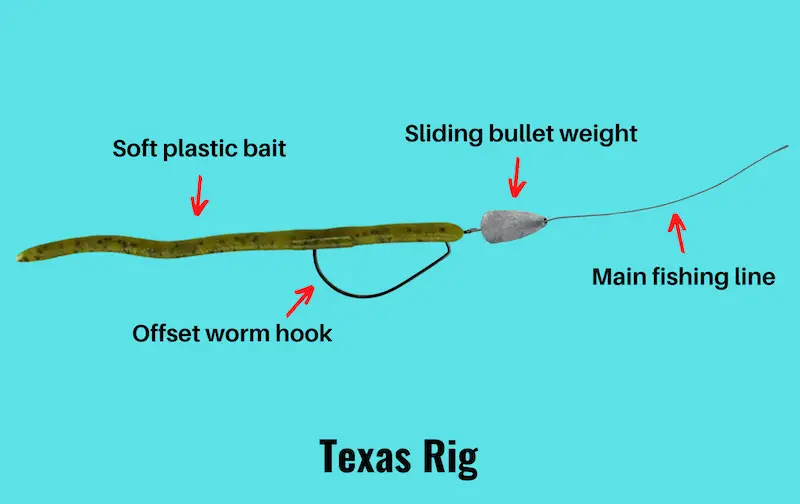
And since the Texas rig can be fished in almost any water depth, it works equally well from the bank as from a boat, making it one of the most versatile bass fishing rigs there is.
Overall, the Texas rig is one of the most popular bass fishing setup that is not only used by experienced bass anglers, but also by beginners “getting their feet wet” with bass fishing.
Finally, there are many modifications to this rig designed to improve its performance in triggering bites from bass lying in heavy cover, and it’s definitely worth having some of these in your tackle box.
Texas rig components
Here are the tackle components you’ll need for your Texas rig setup:
- Sliding bullet sinker (1/8 oz to 1 1/2 oz)
- Offset worm hook (or straight shank hook)
- Soft plastic bait or choice
- Plastic bead (optional)
As you can see, the list of components you need for the Texas rig is very short, explaining why it’s so simple to set up.
The most complex part of the rigging process is threading the plastic bait onto the hook correctly, in order to make the hook weedless (more on that below).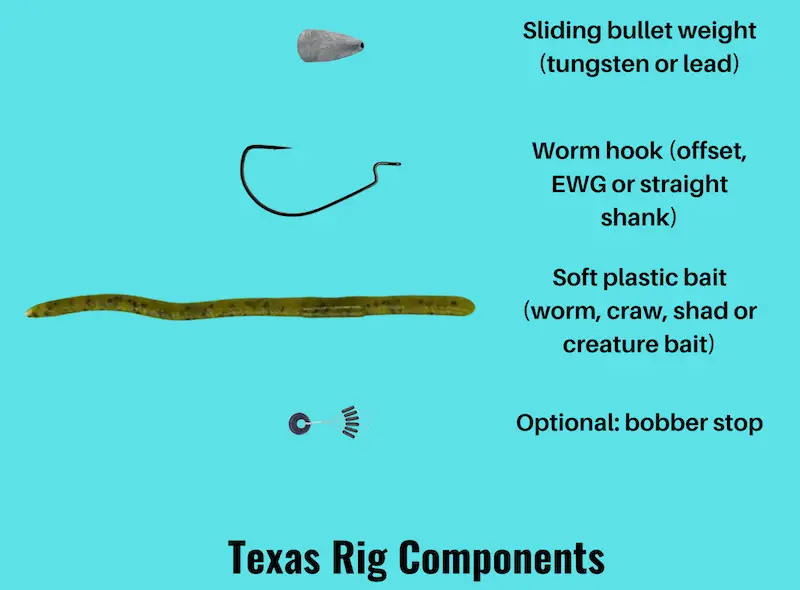
I like to use 20 lb test braided line as my main fishing line, since braid has less stretch, and this supports a powerful hook set (especially at a distance).
However, when using braid, you may want to use a fluorocarbon leader when fishing in clear water, as that has lower visibility, and won’t spook the bass. Alternatively, you can spool 15 to 20 lb test fluoro onto your fishing reel, and in that case won’t need a leader.
In my experience, the best sinker to use for a Texas rig is a sliding tungsten weight, since tungsten is denser than lead or brass. This results in a more compact T-rig, which makes it more weedless.
Choosing the right rod and reel setup for Texas rig fishing
You can fish a Texas rig with either a baitcasting or a spinning rod, as long as you make sure that the rod is heavy enough to drive the hook home through the plastic and into the hard mouth of a bass.
The ideal Texas rig rod is about 7 feet long, and has medium-heavy to heavy power. In terms of rod action, I prefer a fast action rod for T-rig fishing, as that allows me to cast more precisely, which is essential to get the bait into exactly the right spots where I know bass are lurking.
It’s definitely worth getting a rod with a high quality carbon fiber blank, since you want to be able to feel the slightest vibrations through the rod handle, as these can signal subtle bites.
I like to use baitcasting reels for throwing Texas rigs, since they come with more accurate casting, which is helpful in order to get your setup into specific pockets right next to cover.
However, if you’re a beginner, it’s probably better to start with a spinning rod and reel, since casting with a spinning reel is much easier to master. Once you’ve started catching fish regularly with this setup, then you can graduate to a baitcaster, and figure out how to avoid backlash and line twist.
How to tie a Texas rig
Tying a Texas rig is very straight forward. Start by threading the bullet sinker onto your fishing line (with the wide end facing the tag end of the line). Then tie the tag end to the worm hook with a palomar knot (or similar knot).
After tying the hook to the line, it’s time to rig the soft plastic bait perfectly straight on the hook.
The first step is to push the point of the hook into the top (nose) of the bait, pushing it about a quarter of an inch in, and then poke the hook out the side of the plastic bait (as shown in the image below).
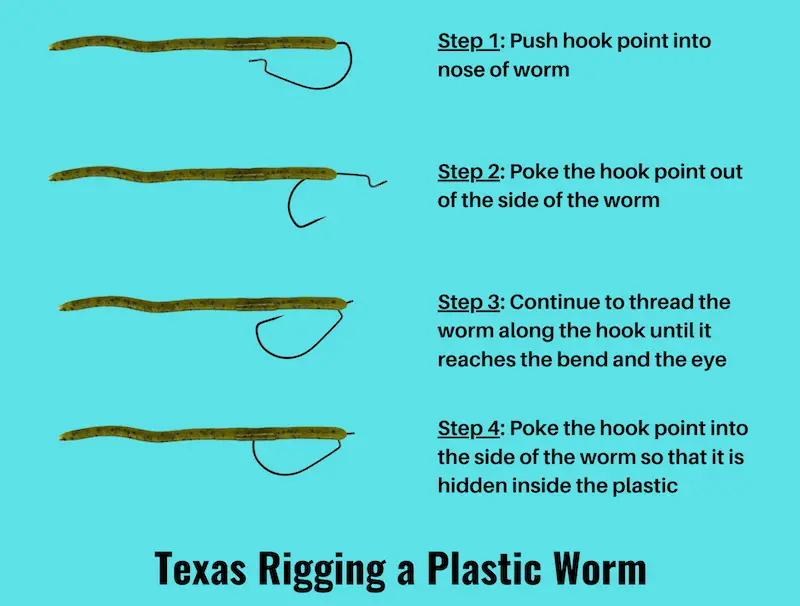
Then continue threading the plastic bait up along the shank of the hook, until the nose of the worm reaches the L-shaped part of the offset hook (also called elbow), which is right next to the eye of the hook.
If you’re using a straight-shank worm hook instead of an offset worm hook, there will be a barb on the end of the shank next to the eye. This serves a similar purpose, which is to keep the nose of the plastic bait in place.
When you’re done with this, the eye of your extra wide gap worm hook should be sitting right at the nose of your soft plastic worm.
In the final step, poke the point of the hook back into the flank of the plastic worm, inserting it just far enough so that the hook point is hidden inside the plastic, to make the rig weedless. The worm should be straight on the hook, to give it the right action in the water.
When fishing around dense cover, a great modification of the Texas rig involves adding a bobber stop right above the sliding sinker. This keeps the sinker close to the hook at all times, and helps to avoid tangles.
What bait should you use with a Texas rig?
The great thing about Texas rigging is that you can choose from a wide variety of soft plastic baits and plastic flipping tubes, and test different types of baits to figure out what the bass want to eat.
I highly recommend regular testing of different baits, since I’ve found that often bass learn to avoid the baits used most often by anglers, while they can still be caught on novel baits or different presentations if they haven’t seen them before.
With that being said, let’s start with the most common bait choice for the Texas rig, which is a soft plastic worm. You can choose from straight tail, ribbon tail and curly tail worms, as well as an infinite variety of colors.
When it comes to choosing bait size for the Texas rig, smaller worms with subtle action and subdued colors are better for cold water or finicky bass, while bigger worms with brighter colors and more exaggerated action are better for bass that are aggressively feeding.
Creature baits are another type of soft plastic lure that performs well when Texas rigged. In my experience, the best of these are craw-style baits, which mimic the movement of crayfish with their flapping appendages in the water.
Soft plastic craws work best in bodies of water that have crawfish populations, and you should always try to imitate the size and the color of crawfish that the bass are accustomed to feeding on.
To make matters even more complicated, the best baits to use with a T rig also change over the seasons, or depending on the weather patterns.
That means you should always have a good collection of soft plastics, ranging from slim worms through broad creature baits and up to bulky craws in your tackle box.
How to fish a Texas rig
While there are many subtle variations of how to fish a Texas rig, one of the simplest methods involves letting it sink to the bottom, and then lifting your rod tip up a foot or two, which causes the worm to swim upwards.
Then lower your rod tip and let the worm sink back to the bottom, reel up the slack, and repeat this until you’ve fully retrieved the bait, before casting it out again.
This basic retrieval tactic more or less consists of dragging the lure across the bottom, and catches fish in most situations.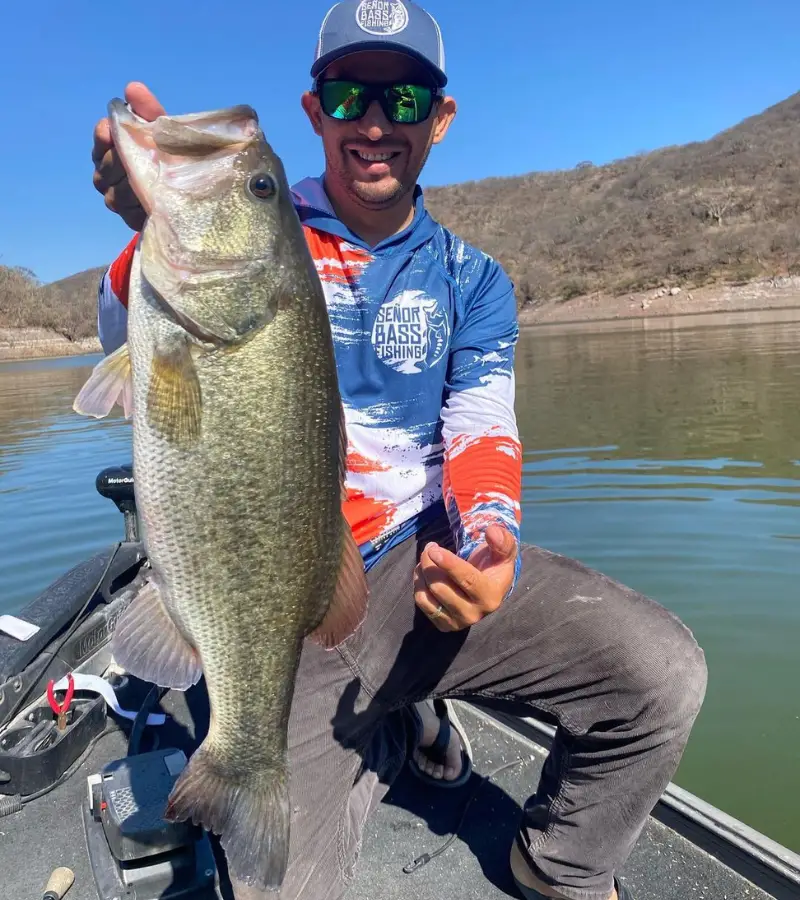
Image source: instagram/@senorbassfishing
However, if you’re dealing with lethargic bass (typically in cooler temperatures), another effective tactic is to move you setup more slowly by sweeping your rod from side to side instead of lifting it.
While the Texas rig is often fished around thick cover, such as shallow weeds and laydowns, it also works well for targeting bass in deeper water, such as deep rocks. If necessary, adjust the size of the sinker to ensure that the rig sinks fast enough.
When casting this setup for bottom fishing close to cover, it’s helpful to master specialized casting techniques such as flipping or pitching, which allow you to cast very accurately at close range.
And always keep a taut line from the rod tip to your hook since you need to react lightning fast and set the hook when a fish grabs the bait, to stop it from wrapping your line around cover, as this can result in breaking off the line.
After you set the hook, don’t give the bass a chance to dive for cover, and instead haul it away from the danger zone as fast as possible, which is another reason for having a heavy action rod.
If you’re interested in using more finesse for bass, check out our article on the drop shot rig.
